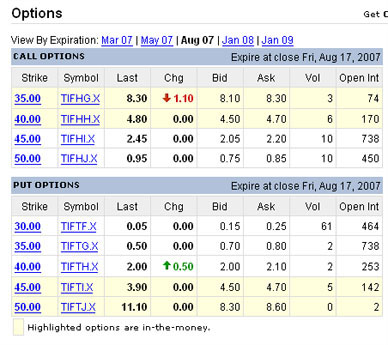It looks like I got to get back on track and finish the “Intro To Option Trading” series of articles.
Let’s continue with part 5
by Das Brain
How do I trade PUT option contracts?
You trade PUT option contracts in a similar fashion as you do CALL option contracts except the direction you are predicting the market or stock price to go is down.
In part 4 of “Intro To Option Trading”, you can see that you can trade option contracts just like stocks, which is buying low and selling high the option contracts themselves. Another term on this is called making money from the spread or the difference in the premium values.
To give a simple example or review, let’s say if you buy 1 option contract at $1.00 and sell that same option contract at $1.95. It doesn’t matter whether its an CALL or PUT option contract for this example. We’re just looking at the spread here, the difference in premium values. You’ve made some money on this trade of course because you sold the option contract higher than what you bought it at. Remember 1 option contract represent 100 shares so you sold at $1.95 X 100 = $195 and you bought at $1.00 X 100 = $100. The take home profit on this is $195 – $100 = $95 then subtract your commissions.
Buying an option contract and holding the option contract doesn’t mean you are obligated to buy or sell the underlying stock. You could very well sell the option contract and make the money from the spread or you sell it to minimize your losses. You close the position before the expiration date.. The other side of the coin is you could do nothing all the way to the expiration date and let it expire worthless (you lose what you paid for the option contracts).
75% off Option Trading E-books at ReadLearnTrade.comÂ
 Remember when you purchase an option contract it either gives you the right to buy or sell the underlying security or stock, but you as described in the last paragraph you can sell the contract or let it expire.
Remember when you purchase an option contract it either gives you the right to buy or sell the underlying security or stock, but you as described in the last paragraph you can sell the contract or let it expire.
Now let’s take a look at how you would trade PUT option contracts. The example underlying stock we are going to use is Tiffany & Co. (NYSE:TIF) and let’s take a look at a current open position I have on TIF. I have purchase 3 PUT contract on TIF with a strike price of $35. Let’s say price I paid for the PUT contracts was $0.65. The current price of NYSE:TIF is $41.86. So why did I buy those contracts.

I am speculating that the underlying stock price NYSE:TIF will fall to around the $35 – $38 range by August 2007 (5 months away). This means that the stock price will have to fall over 5 dollars to hit the low end of that range, and when it starts heading downward then the inverse will happen to the premium or price of the PUT option contract, which is to say that the price of the PUT option contract will rise. For this example, let’s say that it is now July 15th, 2007 and the stock price of NYSE:TIF has fallen to $37 and the PUT contract price I bought is now at $2.00 and I decide to close my position and sell the 3 PUT contracts I purchased before.
So let’s do the math on this example.
Bought 3 contracts X $0.65 = $1.95 X 100 = $195 USD
Sell 3 contracts X $2.00 (current premium price) = $6.00 X 100 (each contract represents 100 shares) = $600 USD.
Profit = $600 – $195 = $405 – $60(commission buy/sell) = $345 USD
So from the above example, you can see that using PUT option contracts you can profit from falling stock prices, where using CALL option contracts you could profit from rising stock prices that is the difference. However, before doing either you should thoroughly research where the major indexes are at, what month of the year it is, and review your charts, because if you get in at the wrong time and the stock price goes the wrong way you could lose.
Please read my DISCLAIMER page.
Bookmark at:
StumbleUpon | Digg | Del.icio.us | Dzone | Newsvine | Spurl | Simpy | Furl | Reddit | Yahoo! MyWeb

